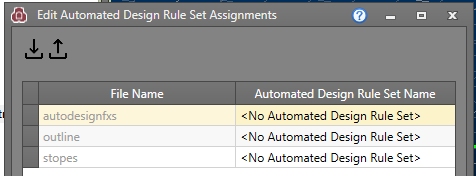Autolayout: Create Line
To use this autolayout action:
-
Edit Automated Design Rules screen >> Action >> Create Line.
This autolayout action is used to add a line to the start or end of other string data.
Note: There is also a Create Multiple Lines autolayout rule that is useful for adding strings at predefined intervals.
Simple Autolayout Example (Create Line action)
In the following example, a two-point FXS design string representing a stope access centreline is used to locate a new string section representing a ventilation shaft. The shaft begins at the end point of the drive string and projects vertically. The two point string object (contained in "autodesignFXS.dm") has already been added to the project using the Settings panel.
The project in this example contains several design definitions, including one to represent a stope access drive and another for a vent raise.
Note: The Create Line action modifies a design string object by adding a new string entity to the table. The existing string data within the assigned object (in this case a table representing a subset of drive strings) won't be modified. Other actions can be used to modify existing data (such as extending a string, for example, or projecting it to a wireframe).
This is the original access string, located on a horizontal plane (an arrow symbol has been added to show the string direction):
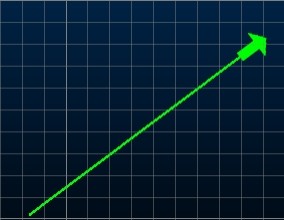
Here's the autolayout example:
-
Activate the Design panel and locate the Automated Design control group.
No autolayout rules or rule sets have yet been defined for this project.
-
Load your design data (button 1, below):

- Open the Edit Automated Design Rules screen.
-
Rule sets are shown on the left, rules for the selected set on the right. On the left of the dialog, click "+" to add a new rule set to the list:
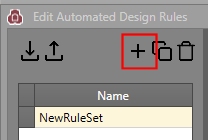
- You can edit the name of the rule set by over-typing. In this case, it is changed to "Stope_Vent_Ruleset".
-
On the right, a table row has been created with some default entries:
Note: A rule set must have at least one rule.
- In this example, the default Action is correct ([Create Line]).
-
The Input Filter is set to <no filter>, meaning it will be applied to the assigned string object in its entirety. For example, if there were 3 open 2-point strings in the design file (as opposed to one in this example), a ventilation raise string would be applied to all of them.
You can apply your rule to a subset of data by filtering. The FXS design string in this example has been connected to a "Stope_Access" design definition. Although filtering isn't necessary in this example, the filter is changed to a design definition representing a stope access string:
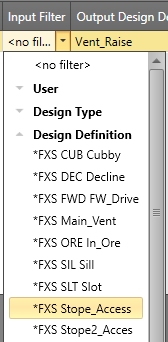
-
The data being created represents a ventilation shaft, and a design definition already exists for this, so it is selected using the Output Design Definition drop-down list:

-
The design of the output ventilation string is defined using the Settings column. To access the settings for the raise, the Create Line Settings screen is launched:

-
The shaft will be 100m in length, at a gradient of 90 degrees. It will start from the end of the stope access string without any offset. The Create Line Settings dialog is filled out like this:
- Click OK to return to the Edit Automated Design Rules screen.
- OK dismisses the Edit Automated Design Rules screen.
-
As it is, the rule has been defined, but not assigned to design data.
To do this, the Edit Automated Design Rule Assignments screen is used:
-
A list of file names appears on the right - these are all design string files associated with your project, for example:
- In this case, the "autodesignFXS" file is being used to construct an automated layout. Select the corresponding Automated Design Rule SetName option [Stope_Vent_Ruleset] to associate the design data with the rule set created previously.
- Click OK.
- In the Design panel (Automated Design group) click Go to process the autolayout rules.
- Click Show Output to see
the progress results and review the design data in the 3D
window:
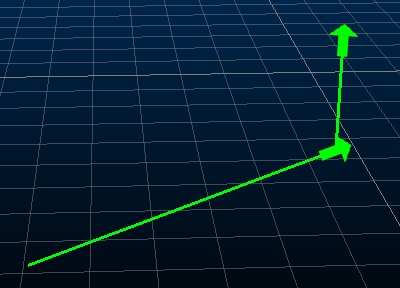
- Save your design data.
-
Continuing the example to show multiple rules, you can delete the newly-created string (select it in the 3D window and press DELETE) and return the original Stope_Vent_Ruleset and add another rule below the original.
The original 2 point string remains in view.
-
You can define another rule, again using Create Line with <no filter> lets you specify more settings. Create a line, 60 units long, at a zero gradient, to the end of qualifying strings (this time, there will be two strings as one will be added using the initial rule):
- Process these rules and you'll see that three new strings are generated:
Autolayout Action Options
The Create Line Settings screen for this action contains the following options:
-
Length – The length of the string to be created.
-
Azimuth – Enter the azimuth of the new string section. This can be set as a real-world azimuth or in relation to the existing design data (relative).
-
Gradient – Define a string gradient n either degrees, % or a ratio.
-
Start Position – Choose to add a curve to either the start or the end of qualifying design data.
-
Distance from Start Position – Specify a positive or negative distance to offset the start of the curve from the start or end of design data.
Related topics and activities





